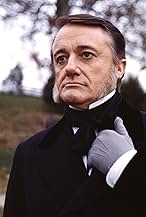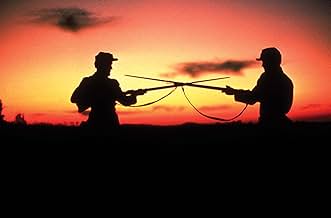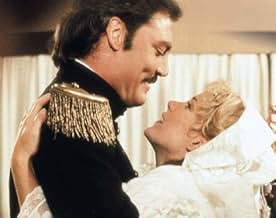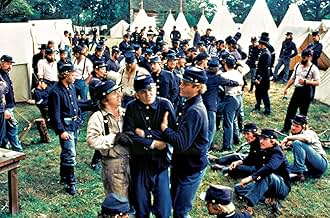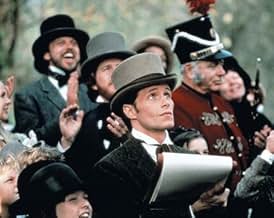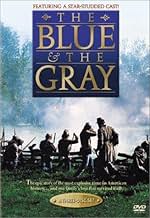Les États-Unis juste avant et pendant la guerre civile, vus à travers les yeux d'un artiste correspondant.Les États-Unis juste avant et pendant la guerre civile, vus à travers les yeux d'un artiste correspondant.Les États-Unis juste avant et pendant la guerre civile, vus à travers les yeux d'un artiste correspondant.
- Nommé pour 4 Primetime Emmys
- 2 victoires et 4 nominations au total
Parcourir les épisodes
Avis à la une
This miniseries shows the war primarily through the eyes of a Virginian who wants to witness history but cannot commit to either side of the conflict. His new-found profession of journalism allows him to participate as a neutral observer. He is surrounded by relatives and friends on both sides, and the miniseries shows events through their eyes as well.
The human side of the war is stressed, and it excellently portrays the toll the conflict took on families.
Many of the subplots are taken from Civil War historian Bruce Catton's final work, "Reflections On The Civil War." However, none of the people in the book, including the real John Geyser, appear in the miniseries. Rather, observations made in the book are woven around the main storyline as supplementary material.
Most of the military aspects of the miniseries are laughable and bear little resemblance to reality. Due to the miniseries being done on a miniseries budget we see none of the grand scale evident in "Gettysburg" or "Glory."
Stacy Keach gives a terrific performance as Jonas Steele, the Federal special operations agent. We see from his performance a little of the decentralized, more personalized ways in which intelligence gathering and other non-standard military operations were conducted in the nineteenth century.
The miniseries ran for over six hours on CBS in 1982, but well over an hour was cut for the two-cassette video release. Get the whole treatment if you can.
The human side of the war is stressed, and it excellently portrays the toll the conflict took on families.
Many of the subplots are taken from Civil War historian Bruce Catton's final work, "Reflections On The Civil War." However, none of the people in the book, including the real John Geyser, appear in the miniseries. Rather, observations made in the book are woven around the main storyline as supplementary material.
Most of the military aspects of the miniseries are laughable and bear little resemblance to reality. Due to the miniseries being done on a miniseries budget we see none of the grand scale evident in "Gettysburg" or "Glory."
Stacy Keach gives a terrific performance as Jonas Steele, the Federal special operations agent. We see from his performance a little of the decentralized, more personalized ways in which intelligence gathering and other non-standard military operations were conducted in the nineteenth century.
The miniseries ran for over six hours on CBS in 1982, but well over an hour was cut for the two-cassette video release. Get the whole treatment if you can.
This was a very good film about the Civil War. It showed the mindset of people living in the south during that era; how they were swayed into entering a futile and dangerous undertaking. The agony of war was shown at its worst, depicting the loss of the combatants as well as bystanders. Any war is horrible, but the war between the states is more so because of its utter uselessness. The waste of life and material should never have been allowed to happen. I recommend this movie; the action sequences are dramatic and well done, however, I felt some of the scenes seemed a bit underpopulated.
Back in the early Sixties there was a short lived television series called The Americans about two brothers who after their father was killed decided to fight on opposite sides in the Civil War. The whole business about brother against brother was no exaggeration. Right up to the very top with Mary Todd Lincoln having relatives who fought for the Confederacy, families were torn apart. The Blue And The Gray brings that aspect of the Civil War better than any other film made for the big or small screen since The Americans.
The families are the Geysers and the Hales related by the mothers, Diane Baker and Colleen Dewhurst being sisters. The Hales are from Gettysburg, Pennsylvania and the Geysers from what would now be West Virginia in and around Harper's Ferry and that's not even 100 miles distance. But the families are true to the sectional divide.
With the exception of John Geyser played by John Hammond who has made a black friend, a free man played by Paul Winfield who gets lynched for helping runaway slaves. He won't fight for a section that espouses slavery as a cause, but won't enlist in the Northern Armies either. A passing acquaintance played by Stacy Keach who gets himself involved in a lot of the major events of the war and married into the Hale family with Julia Duffy persuades Hammond to become a war correspondent and put his artistic talents to good use. Hammond becomes a pictorial chronicler of the seminal event of his generation.
Without ever losing control of the main story lines, what happens to the various Geyser and Hale family members, The Blue And The Gray captures the sweep and pageantry of the Civil War. Such real characters as Abraham Lincoln played by Gregory Peck and John Brown played by Sterling Hayden in what was his farewell performance do take a life of their own. With Peck we see a public and a private Lincoln which is true to the Lincoln mythology and yet quite a human character.
If I had to single out one performance that was especially touching it would be that of David W. Harper as one of the Hale brothers. The young man was eager to be the first to enlist in his town of Gettysburg, but he never made it to the battle that town became famous for. A not well covered portion of the war was the lack of sanitary facilities in army camps. Young Harper falls victim to dysentery and his performance will move you.
A few years later North and South covered a lot of the same ground that this particular mini-series did and it was as well done as The Blue And The Gray. I would recommend them both highly especially for young audiences to gain a real understanding of what the Civil War meant to the average individual/
The families are the Geysers and the Hales related by the mothers, Diane Baker and Colleen Dewhurst being sisters. The Hales are from Gettysburg, Pennsylvania and the Geysers from what would now be West Virginia in and around Harper's Ferry and that's not even 100 miles distance. But the families are true to the sectional divide.
With the exception of John Geyser played by John Hammond who has made a black friend, a free man played by Paul Winfield who gets lynched for helping runaway slaves. He won't fight for a section that espouses slavery as a cause, but won't enlist in the Northern Armies either. A passing acquaintance played by Stacy Keach who gets himself involved in a lot of the major events of the war and married into the Hale family with Julia Duffy persuades Hammond to become a war correspondent and put his artistic talents to good use. Hammond becomes a pictorial chronicler of the seminal event of his generation.
Without ever losing control of the main story lines, what happens to the various Geyser and Hale family members, The Blue And The Gray captures the sweep and pageantry of the Civil War. Such real characters as Abraham Lincoln played by Gregory Peck and John Brown played by Sterling Hayden in what was his farewell performance do take a life of their own. With Peck we see a public and a private Lincoln which is true to the Lincoln mythology and yet quite a human character.
If I had to single out one performance that was especially touching it would be that of David W. Harper as one of the Hale brothers. The young man was eager to be the first to enlist in his town of Gettysburg, but he never made it to the battle that town became famous for. A not well covered portion of the war was the lack of sanitary facilities in army camps. Young Harper falls victim to dysentery and his performance will move you.
A few years later North and South covered a lot of the same ground that this particular mini-series did and it was as well done as The Blue And The Gray. I would recommend them both highly especially for young audiences to gain a real understanding of what the Civil War meant to the average individual/
As others have mentioned, this is a series of recollections of events which may (or may not) have occurred during the American Civil War. It is related from the point of view of a 'neutral' war correspondent, who's talent is for drawing sketches of what he has seen on various battle fields, from Bull Run to Appomattox Ct. House. There is considerable 'time jumping' from one period of the war, to another, which inhibits continuity to some extent. For me the best part of the mini-series was watching Gregory Peck (as Abraham Lincoln) deliver the Gettysburg address. However, we are thrown into that scene without adequate preamble, so even this is diminished from what it could have been.
I am quite an avid amateur Civil War historian, having read many books and watched many TV series (including the excellent PBS series by Ken Burns, and the complete 3 volume set of books on the Civil War by historian Shelby Foote) on the subject. If you are looking for historical accuracy you will be disappointed. If you, on the other hand, are simply looking for a decent dramatization (ala "Gone With the Wind), you will enjoy this series.
The acting by the cast was, in general, C+, with the exception of a few of the notables (Gregory Peck, for one). As my summary states, this is a dramatic romp, so if you keep that in mind and set your sites correspondingly on the low side, you will not be disappointed.
I am quite an avid amateur Civil War historian, having read many books and watched many TV series (including the excellent PBS series by Ken Burns, and the complete 3 volume set of books on the Civil War by historian Shelby Foote) on the subject. If you are looking for historical accuracy you will be disappointed. If you, on the other hand, are simply looking for a decent dramatization (ala "Gone With the Wind), you will enjoy this series.
The acting by the cast was, in general, C+, with the exception of a few of the notables (Gregory Peck, for one). As my summary states, this is a dramatic romp, so if you keep that in mind and set your sites correspondingly on the low side, you will not be disappointed.
I did not see this movie when it was shown as a mini-series.I happened to like this movie because it gave a simple portrayal of what it might have been like to be a family during this period and having to face the problem of a family that was divided in its loyalties . I thought the makers of this movie followed the history of the period and gave a good presentation of the issues that the people had to deal with at the time. Of course it cannot compare to the recent Civil War Movies or even the Ken Burns series . Given the time that it was made I think it was a good portrayal of the period.
My only fault with the movie was the fact that it seemed to put the fall of Vicksburg after the Gettysburg Address. I did not understand how this was allowed to happen given the fact that it seemed to be based on Bruce Catton's work. Can anyone explain this?
My only fault with the movie was the fact that it seemed to put the fall of Vicksburg after the Gettysburg Address. I did not understand how this was allowed to happen given the fact that it seemed to be based on Bruce Catton's work. Can anyone explain this?
Le saviez-vous
- AnecdotesSome filming took place at Prairie Grove Battlefield State Park in Arkansas. The film crew built a false side onto a historic building there, then blew it off for a special effect, assuring the State park officials that no harm would come to the building. The explosion was larger than promised, damaging the historic house's structure.
- GaffesWhen John Brown is hanged for the uprising at Harper's Ferry, the apple trees are in full blossom. John Brown was hanged on 2 December 1859.
- Citations
Abraham Lincoln: It's well known that the more a man speaks, the less he's understood.
- ConnexionsReferenced in Saturday Night Live: Drew Barrymore/Squeeze (1982)
- Bandes originalesRock of Ages
Lyrics by Augustus Montague Toplady (as Augustus M. Toplady)
Music by Thomas Hastings
Meilleurs choix
Connectez-vous pour évaluer et suivre la liste de favoris afin de recevoir des recommandations personnalisées
- How many seasons does The Blue and the Gray have?Alimenté par Alexa
Détails
- Date de sortie
- Pays d’origine
- Langue
- Aussi connu sous le nom de
- Die Blauen und die Grauen
- Lieux de tournage
- Sociétés de production
- Voir plus de crédits d'entreprise sur IMDbPro
Contribuer à cette page
Suggérer une modification ou ajouter du contenu manquant


